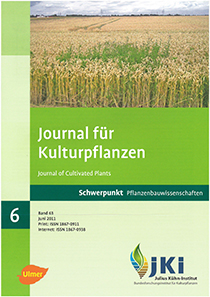Yield trend of winter wheat with varying N fertilization
Keywords:
Wheat, yield trends, nitrogen fertilization, yield optimumAbstract
Long-term field experiments allow identifying and quantifying trends. A field trial was set up in 1974 at the Hohenschulen Experimental Farm in Schleswig-Holstein (Northern Germany) to test different nitrogen (N) treatments in wheat. N fertilization varied in timing and total amount. 0, 40, 80 or 120 kg N ha–1 were applied each at the beginning of spring growth, at stem elongation (GS 30) and at ear emergence (GS 50/51) in any possible combination resulting in 64 (4*4*4) N treatments ranging from 0 to 320 kg N ha–1. The cultivar Diplomat was grown from the trial set up until 2002, whereas Kanzler (1983–1991), Orestis (1992–1995), Ritmo (1996–2004) und Tommi (since 2005) were parallelly tested as newer genotypes. Yield in the unfertilized control, optimal N amount and the respective grain yield were estimated from the year and genotype specific N response curves (quadratic polynomial function based on the total N amount). Linear regression was used to test for trends in these coefficients. Grain yield without N fertilization showed no trend. However, yield of the optimal fertilized treatment increased by 0.063 t ha–1 a–1. Yield trend was similar in all varieties, but at different levels indicating genetic improvements. In contrast, the optimal N amount was not affected. Grain protein concentration correlated negatively with the yield level, whereas only a poor relationship between optimal N amount and the respective yield occurred. As causes for the trend in the optimal yield changes in crop management, average mean temperature or CO2 concentration in the atmosphere are discussed.
DOI: 10.5073/JfK.2011.06.01, https://doi.org/10.5073/JfK.2011.06.01








